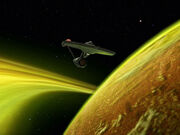(Added more detail) |
No edit summary Tag: sourceedit |
||
| (37 intermediate revisions by 25 users not shown) | |||
| Line 1: | Line 1: | ||
| + | [[File:Mudd.jpg|thumb|Mudd, a class K planet]] |
||
| ⚫ | |||
| + | In the [[Federation]] standard system of [[planetary classification]], a '''class K''' (or '''K type''') [[planet]] was characterized as being adaptable for [[Human]]s by use of [[pressure dome]]s and [[life support system]]s. An example of a class K planet is [[Mudd]]. ({{TOS|I, Mudd}}) |
||
| ⚫ | |||
| − | Examples of Class K planets include: [[Mars]] and [[Mudd]]. |
||
| + | [[Starfleet General Orders and Regulations#Starfleet Transfer Regulations|Starfleet Transfer Regulations]] included provisions regarding special environmental support for Class-K. Native Personnel. ({{TNG|The Measure Of A Man}}) |
||
| ⚫ | |||
| + | {{bginfo|Since this type of planet has a solid surface unlike a Jovian planet, the "transjovian" label probably refers to its orbital location relative to the Jovians in its system.}} |
||
| − | ==== Note ===== |
||
| + | |||
| − | The first part is partly information from the [[Star Trek Star Charts]]. The second part is conjecture based on on-screen information from ([[TNG]]: "[[The Royale]]"). |
||
| + | {{Planetary classification}} |
||
| + | == Background == |
||
| ⚫ | According to the non-canon publication ''[[Star Trek: Star Charts]]'', Class K planets are called "adaptable". These planets have an age that ranges from four to ten billion years and a diameter that ranges from 5,000 to 10,000 kilometers. A Class K planet is found within the ecosphere of a [[star system]]. They are categorized by a barren surface with little or no surface [[water]] and a thin [[atmosphere]] comprised mainly of [[carbon dioxide]]. [[Lifeform]]s found on Class K planets are limited to single-celled organisms, although Class K planets can be adapted for [[humanoid]] life through the use of pressure domes. According to the criteria, [[Mars]] could be considered a Class K planet (as could [[Tyrellia]]). |
||
| + | |||
| + | |||
| + | [[de:Klasse K]] |
||
| + | [[ja:Kクラス]] |
||
| + | [[nl:Klasse K]] |
||
| + | [[Category:Astronomical classifications|K]] |
||
| + | [[Category:Astronomical objects]] |
||
Revision as of 06:25, 8 April 2015

Mudd, a class K planet
In the Federation standard system of planetary classification, a class K (or K type) planet was characterized as being adaptable for Humans by use of pressure domes and life support systems. An example of a class K planet is Mudd. (TOS: "I, Mudd")
The transjovian subtype of this class is used for harsh planets such as Theta VIII, with average surface temperatures well below 0 °C and an atmosphere consisting of methane, nitrogen and liquid neon. (TNG: "The Royale")
Starfleet Transfer Regulations included provisions regarding special environmental support for Class-K. Native Personnel. (TNG: "The Measure Of A Man")
| Planetary classification |
|---|
| B • D • G • H • J • K • L • M • N • R • T • Y • Other classes |
Background
According to the non-canon publication Star Trek: Star Charts, Class K planets are called "adaptable". These planets have an age that ranges from four to ten billion years and a diameter that ranges from 5,000 to 10,000 kilometers. A Class K planet is found within the ecosphere of a star system. They are categorized by a barren surface with little or no surface water and a thin atmosphere comprised mainly of carbon dioxide. Lifeforms found on Class K planets are limited to single-celled organisms, although Class K planets can be adapted for humanoid life through the use of pressure domes. According to the criteria, Mars could be considered a Class K planet (as could Tyrellia).
